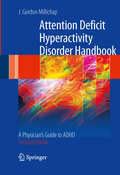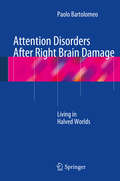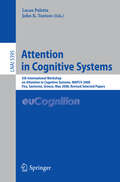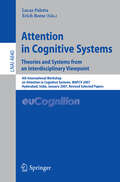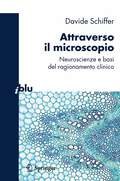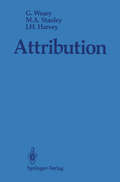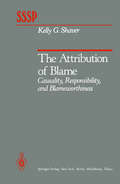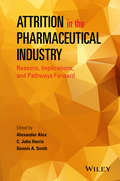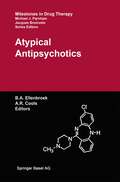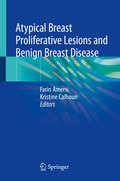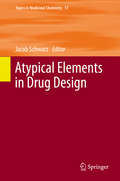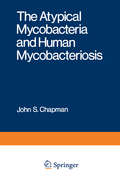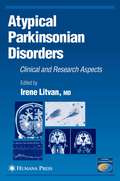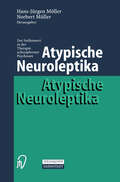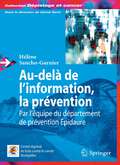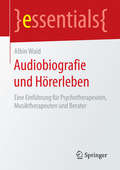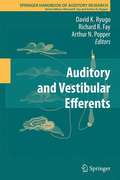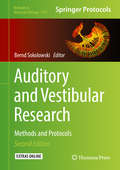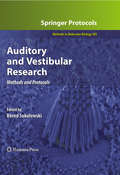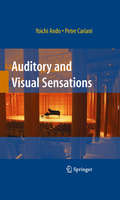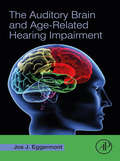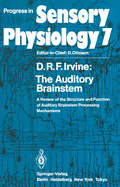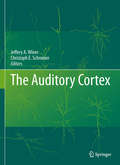- Table View
- List View
Attention Deficit Hyperactivity Disorder Handbook: A Physician's Guide to ADHD
by J. Gordon MillichapAn expanded, updated, and revised edition, the ADHD Handbook, second edition covers recent advances in causes and management of ADHD, and includes more than 400 scientific references to peer-reviewed articles. It provides answers to the numerous questions that surround ADHD, including how is it diagnosed? What causes ADHD? What are the risks of associated learning and behavior disorders, tics, seizures, and headaches? What treatments are available? What are the choices of medications and the risks of side effects? How can adverse effects be avoided? What are the alternatives to medication? Do children outgrow ADHD, and how long is treatment required? ADHD Handbook is written for neurologists, pediatricians, practicing physicians, residents, fellows and students of medicine, psychologists, educators, occupational and speech therapists, nurse practitioners and other healthcare providers. It also offers parents a readable, but uniquely well documented and objective account of ADHD symptoms, diagnosis, medications, alternative treatments, and management.
Attention Disorders After Right Brain Damage: Living in Halved Worlds
by Paolo BartolomeoThis book provides an overview of attentional impairments in brain-damaged patients from both clinical and neuroscientific perspectives, and aims to offer a comprehensive, succinct treatment of these topics useful to both clinicians and scholars. A main focus of the book concerns left visual neglect, a dramatic but often overlooked consequence of right hemisphere damage, usually of vascular origin, but also resulting from other causes such as neurodegenerative conditions. The study of neglect offers a key to understand the brain’s functioning at the level of large-scale networks, and not only based on discrete anatomical structures. Patients are often unaware of their deficits (anosognosia), and often obstinately deny being hemiplegic. Diagnosis is important because neglect predicts poor functional outcome in stroke. Moreover, effective rehabilitation strategies are available, and there are promising possibilities for pharmacological treatments.Attention Disorders After Right Brain Damage is aimed at clinical neurologists, medics in physical medicine and rehabilitation, clinical psychologists and neuropsychologists. It will also be useful for graduate students and medical students who wish to understand the topic of attention systems and improve their knowledge of the neurocognitive mechanisms of attentional deficits. In addition, clinical researchers in neuropsychology and cognitive neuroscience will find in this book an up to date overview of current research dealing with the attention systems of the human brain.
Attention in Cognitive Systems: International Workshop on Attention in Cognitive Systems, WAPCV 2008 Fira, Santorini, Greece, May 12, 2008, Revised Selected Papers (Lecture Notes in Computer Science #5395)
by Lucas Paletta John K. TsotsosAttention has represented a core scienti?c topic in the design of AI-enabled systems in the last few decades. Today, in the ongoing debate, design, and c- putationalmodelingofarti?cialcognitivesystems,attentionhasgainedacentral position as a focus of research. For instance, attentional methods are considered in investigating the interfacing of sensory and cognitive information processing, for the organization of behaviors, and for the understanding of individual and social cognition in infant development. Whilevisualcognitionplaysacentralroleinhumanperception,?ndingsfrom neuroscience and experimental psychology have provided strong evidence about the perception–action nature of cognition. The embodied nature of senso- motor intelligence requires a continuous and focused interplay between the c- trolofmotoractivitiesandtheinterpretationoffeedbackfromperceptualmod- ities. Decision making about the selection of information from the incoming sensory stream – in tune with contextual processing on a current task and an agent’s global objectives – becomes a further challenging issue in attentional control. Attention must operate at interfaces between a bottom-up-driven world interpretationandtop-down-driveninformationselection,thusactingatthecore of arti?cial cognitive systems. These insights have already induced changes in AI-related disciplines, such as the design of behavior-based robot control and the computational modeling of animats. Today, the development of enabling technologiessuch as autonomous robotic systems,miniaturizedmobile–evenwearable–sensors,andambientintelligence systems involves the real-time analysis of enormous quantities of data. These data have to be processed in an intelligent way to provide “on time delivery” of the required relevant information. Knowledge has to be applied about what needs to be attended to, and when, and what to do in a meaningful sequence, in correspondence with visual feedback.
Attention in Cognitive Systems. Theories and Systems from an Interdisciplinary Viewpoint: 4th International Workshop on Attention in Cognitive Systems, WAPCV 2007 Hyderabad, India, January 8, 2007 Revised Selected Papers (Lecture Notes in Computer Science #4840)
by Lucas Paletta Erich RomeThis volume provides a much-needed interdisciplinary angle on the subject of attention in cognitive systems. It constitutes the thoroughly refereed post-workshop proceedings of the 5th International Workshop on Attention in Cognitive Systems, held in Hyderabad, India, in January 2007. The 31 papers are organized in topical sections that cover every aspect of the subject, from the embodiment of attention and its cognitive control, to the applications of attentive vision.
Attraverso il microscopio: Neuroscienze e basi del ragionamento clinico (I blu)
by Davide SchifferIl libro prende le mosse dai pensieri di un giovane che alla maturità liceale si trova affascinato dalla cultura dei classici greco-latini, dai rudimenti filosofici e dall’impatto con le scienze fisiche e naturali. Il latino e i suoi naturalisti hanno suscitato un fervore verso la Botanica Sistematica che lo riporta a Linneo e quindi alla conoscenza del mondo naturale, all’esperienza della denominazione dell’esistente come conoscenza e quindi agli universali di Guglielmo d’Occam. La scelta della facoltà di Medicina fungerà da mediazione fra la filosofia, vista come via alla verità, e la biologia con il grande mistero dell’uomo nella sua dualità di mente/corpo. L’incontro con il microscopio aprirà la strada all’approfondimento della biologia, ma anche alla ricerca dei significati e delle interpretazioni del mondo. I meccanismi della percezione, visiva in particolare, nelle articolazioni della Gestaltpsychologie, e i suoi rapporti con il mondo interiore, sia quello della memoria esplicita che della memoria implicita, sono affrontati nell’esplorazione del mondo attraverso il microscopico e nella ricerca di una obiettività scientifica. Locke e Kant, Popper e Heidegger fanno da contraltare a Ramon y Cajal, Golgi, Kandel, Heisenberg, mentre la semiotica illumina e confonde sull’importanza del linguaggio per la conoscenza. Il segno e il suo riconoscimento si trasferiscono nella scienza attraverso l’inter-soggettività e il linguaggio appare come l’unico modo di penetrare l’esistente. Il libro si dilunga sull’origine di certe denominazioni in patologia tratte dalla vita quotidiana, sull’antropomorfismo spesso applicato agli oggetti del campo microscopico, sempre illustrati su base fenomenologica e psicologica.
Attribution
by Gifford Weary Melinda A. Stanley John H. HarveyThis book initially was conceived in 1986 by Weary and Harvey as a revi sion and update of their 1981 Perspectives on Attributional Processes (pub lished by Wm. C. Brown," Dubuque, Iowa). However: toe extensive nature of recent work on attributional processes and the opportunity to collabo rate with Melinda Stanley as a coauthor led to a plan to develop a more comprehensive work than the 1981 book. It definitely is an amalgam of our interests in social and clinical psychology. It represents our commitment to basic theoretical and empirical inquiry blended with the applications of ideas and methods to understanding attribution in more naturalistic set tings, and as it unfolds in the lives of different kinds of people coping with diverse problems of living. The book represents a commitment also to the breadth of approach to attribution questions epitomized by Fritz Heider's uniquely creative mind and work in pioneering the area. To us, the attribu tional approach is not a sacrosanct school of thought on the human condi tion. It is, rather, a body of ideas and findings that we find to be highly useful in our work as social (JH and GW) and clinical (GW and MS) psychology scholars. It is an inviting approach that, as we shall describe in the book, brings together ideas and work from different fields in psychology-all concerned with the pervasive and inestimab1e importance of interpretive activity in human experience and behavior.
The Attribution of Blame: Causality, Responsibility, and Blameworthiness (Springer Series in Social Psychology)
by K.G. ShaverHow can we identify the causes of events? What does it mean to assert that someone is responsible for a moral affront? Under what circumstances should we blame others for wrongdoing? The related, but conceptually distinct, issues of causality, responsibility, and blameworthiness that are the subject of this book play a critical role in our everyday social encounters. As very young children we learn to assert that "it wasn't my fault," or that "I didn't mean to do it." Responsibility and blame follow us into adulthood, as personal or organizational failings require explanation. Although judgments of moral accountability are quickly made and adamantly defended, the process leading to those judgments is not as simple as it might seem. Psychological research on causality and responsibility has not taken complete advantage of a long tradition of philosophical analysis of these concepts. Philosophical discussions, for their part, have not been sufficiently I1ware of the psychological realities. An assignment of blame is a social explanation. It is the outcome of a process that begins with an event having negative consequences, involves judgments about causality, personal responsibility, and possible mitigation. The result can be an assertion, or a denial, of individual blameworthiness. The purpose of this book is to develop a comprehensive theory of how people assign blame.
Attrition in the Pharmaceutical Industry: Reasons, Implications, and Pathways Forward
by Alexander Alex C. John Harris Dennis A. SmithWith a focus on case studies of R&D programs in a variety of disease areas, the book highlights fundamental productivity issues the pharmaceutical industry has been facing and explores potential ways of improving research effectiveness and efficiency. • Takes a comprehensive and holistic approach to the problems and potential solutions to drug compound attrition• Tackles a problem that adds billions of dollars to drug development programs and health care costs• Guides discovery and development scientists through R&D stages, teaching requirements and reasons why drugs can fail• Discusses potential ways forward utilizing new approaches and opportunities to reduce attrition
Attrition in the Pharmaceutical Industry: Reasons, Implications, and Pathways Forward
by Alexander Alex C. John Harris Dennis A. SmithWith a focus on case studies of R&D programs in a variety of disease areas, the book highlights fundamental productivity issues the pharmaceutical industry has been facing and explores potential ways of improving research effectiveness and efficiency. • Takes a comprehensive and holistic approach to the problems and potential solutions to drug compound attrition• Tackles a problem that adds billions of dollars to drug development programs and health care costs• Guides discovery and development scientists through R&D stages, teaching requirements and reasons why drugs can fail• Discusses potential ways forward utilizing new approaches and opportunities to reduce attrition
Atypical Antipsychotics (Milestones in Drug Therapy)
by Bart A. Ellenbroek Alexander R. CoolsThe introduction of chlorpromazine in 1953, and haloperidol in 1958, into clinical practice dramatically altered the therapy of schizophrenic patients. Although representing by no means a cure for this severe psychiatric ill ness, it allowed, for the first time, to adequately control the severe hallu cinations and delusional beliefs which prevent these patients from leading a more or less independent life. Indeed these antipsychotics (and the many congeners that were to follow) significantly reduced the number ofchronic schizophrenic inpatients in psychiatric clinics all over the world. However soon after their introduction it became clear that, like all other available drugs, antipsychotics were by no means miracle drugs. In fact, two major problems appeared. First, the antipsychotics had very little effect on the so-called negative or defect symptoms, like social isolation, apathy and anhedonia, and secondly virtually all antipsychotics produced a number of side-effects, of which the neurological (often called extra pyramidal) side-effects were the most troublesome. Especially the tardive dyskinesia, which occurred in about 15 to 20% of the patients after pro longed treatment, represented a major problem in the treatment of schizo phrenic patients.
Atypical Breast Proliferative Lesions and Benign Breast Disease
by Farin Amersi Kristine CalhounManagement of atypical breast lesions continues to evolve. There is considerable controversy as to whether these entities represent risk factors for future breast cancer or whether they are instead precursor lesions. A better understanding of the prognostic and therapeutic implications of each of these lesions is important for assessing subsequent breast cancer risk. Risk assessment tools are available for screening high risk patients and understanding the utility and limitations of these tools is important for all clinicians involved in the care of patients. There have been significant advances in breast cancer screening in the last several year including breast tomosynthesis, automated breast ultrasound, molecular imaging, as well as accelerated breast MRI protocols. This has raised the question: Do women at risk for breast cancer need additional breast cancer screening using these newer imaging modalities? In addition, with these advances in imaging, can women with atypical proliferative lesions be observed rather than undergoing surgical excision as some suggest? The role of observation, surgical excision and even prophylactic mastectomy in women with atypical proliferative lesions continues to be debated; however there is data that can guide physicians in the management of these patients. Pleomorphic Lobular carcinoma in-situ (PLCIS) is a distinct pathological entity within LCIS and there is no consensus regarding surgical margins or the need for adjuvant treatment to prevent recurrence. Recently, ductal carcinoma in-situ (DCIS) has been the subject of much controversy: is it truly a cancer or is it instead a precursor lesion. The traditional management of DCIS with lumpectomy and radiation is now being debated and recent data demonstrates that low grade DCIS can be managed with observation. Clinical trials are now accruing patients with low and intermediate grade DCIS to observation and close surveillance, and not surgical excision. Finally, new guidelines for chemoprevention with the use of tamoxifen and raloxifen for women with atypical proliferative lesions, LCIS, PLCIS, and DCIS are available and should be discussed as an option when guiding management of these patients. This book will provide a comprehensive review of this field and will serve as a valuable resource for clinicians, general surgeons, breast surgeons and surgical oncologists, as well as researchers with an interest in the management of atypical breast lesions. The book will review new data about breast cancer, risk factors for breast cancer, pathological features unique to each entity, the characteristic findings on imaging, risk stratification for genetic testing, as well as the current evidence-based management of each of these breast lesions. Our text will provide assessment tools for risk prediction of breast cancer. We will provide data on the current imaging modalities, as well as advanced screening options available for diagnosis and following these patients. Current management of many of these lesions continues to be controversial in regard to observation with close surveillance versus the need for surgical excision of these lesions based on future risk or whether these lesions are precursor lesion. For ductal carcinoma in-situ, the debate continues in regards to whether this disease entity is a precursor lesion that can be managed with observation or hormonal therapy, or is DCIS cancer and treated with lumpectomy and radiation. Several studies have been published where patients are managed with observation and treatment with hormonal therapy before surgical management. New trials have already begun accruing patients with low to intermediate grade DCIS where patients will be managed with observation versus hormonal therapy only. Management of DCIS continues to evolve and current management will be discussed This text will provide a concise but comprehensive summary of the current management of patients with atypical breast proliferative lesions and some benign breast lesions and will help guided management of these
Atypical Elements in Drug Design (Topics in Medicinal Chemistry #17)
by Jacob SchwarzMedicinal chemistry is both science and art. The science of medicinal chemistry offers mankind one of its best hopes for improving the quality of life. The art of medicinal chemistry continues to challenge its practitioners with the need for both intuition and experience to discover new drugs. Hence sharing the experience of drug research is uniquely beneficial to the field of medicinal chemistry. Drug research requires interdisciplinary team-work at the interface between chemistry, biology and medicine. Therefore, the topic-related series Topics in Medicinal Chemistry covers all relevant aspects of drug research, e.g. pathobiochemistry of diseases, identification and validation of (emerging) drug targets, structural biology, drugability of targets, drug design approaches, chemogenomics, synthetic chemistry including combinatorial methods, bioorganic chemistry, natural compounds, high-throughput screening, pharmacological in vitro and in vivo investigations, drug-receptor interactions on the molecular level, structure-activity relationships, drug absorption, distribution, metabolism, elimination, toxicology and pharmacogenomics. In general, special volumes are edited by well known guest editors.
The Atypical Mycobacteria and Human Mycobacteriosis (Current Topics in Infectious Disease)
by John ChapmanNearly twenty years ago a symposium convened at Dallas, Texas, to con sider the place of atypical mycobacteria among agents of human disease. An edited and condensed version of that symposium was subsequently published and since that time has constituted the only bound source of infor mation covering broad aspects of mycobacterial disease. In the years since a vast amount of information has accumulated in periodical literature, some of which is not readily accessible. The time seems suitable for a comprehensive collection of this scattered material into a single book. The aim has not been to produce an exhaustive account of mycobacteria and mycobacterioses, but rather to concentrate on salient points and particularly on those most generally useful to a diverse group of interests: mycobacteriology, pathology, epidemiology, and, of course, clinical fields. In Appendix A there appear in summary form manifestations of myco bacteria as they have occurred among clinical specialities, such as ortho pedic surgery, dermatology, and urology. These summaries are designed to serve as guides to more probable infections and to lead to more extensive reading with respect to the specific organism encountered. Appendix C presents, also in summary form, drugs, regimens, duration of treatment, and toxicities to permit ready reference to less familiar anti microbial agents. These are suggestive only, useful when the general nature of the organism is known but not the specific susceptibility of the individual strain.
Atypical Parkinsonian Disorders: Clinical and Research Aspects (Current Clinical Neurology)
by Irene LitvanA comprehensive review of what is known not only about the cause and treatment of atypical parksonian disorders, but also the issues that clinicians, researchers, patients, and caregivers face in dealing with them. The authors cover the basic science (history, epidemiology, genetics, pathology, nosology, computer modeling, and animal models), detailed clinical and laboratory assessments, and available diagnostic tools, including neuropsychiatric, neurologic, neuropsychologic, speech, electrophysiologic, and imaging evaluations. Current and future therapeutic approaches are also detailed, along with extensive discussions about future research directions.
Atypische Neuroleptika: Der Stellenwert in der Therapie schizophrener Psychosen
by Hans-Jürgen Möller Norbert MüllerAtypische Neuroleptika: Der Stellenwert in der Therapie schizophrener Psychosen
by Hans-Jürgen Möller Norbert MüllerAu-delà de l'information, la prévention: Par l’équipe du département de prévention Épidaure (Dépistage et cancer)
by Hélène Sancho-Garnier Daniel SerinLa prévention des pathologies les plus fréquentes et les plus mortelles (cancers, maladies cardiovasculaires, accidents) passe essentiellement par la modification des comportements à risque, défi qui ne peut être résolu par la simple diffusion d’informations. Pour pouvoir modifier les comportements, il faut tenir compte d’une part, des individus eux-mêmes et de ce qui les amène à changer leurs manières de vivre et, d’autre part, de l’environnement culturel, social, physique et économique qui façonne les personnes et dont les modifications sont nécessaires aux changements individuels. Ainsi, les actions de prévention en matière de santé sont efficaces pour autant qu’elles renforcent la capacité à exercer un contrôle sur les déterminants de santé individuels et collectifs. Pour être plus efficaces, les programmes doivent donc inclure des stratégies multiples dont l’objectif est à la fois de changer le contexte sociétal et de changer les valeurs de vie des individus. Le centre de prévention Épidaure, ouvert en 1988, a pour mission la prévention des cancers. Son équipe pluridisciplinaire organise son activité autour de trois axes : recherche en pédagogie et préventologie, formation dans les mêmes domaines et mise en place, avec divers partenaires, d’interventions de prévention. C’est le fruit de ces quinze années d’expérience que l’équipe d’Épidaure a voulu transmettre dans ce livre, une partie théorique sur les possibilités d’action sur les comportements et une partie plus pratique rapportant les expériences d’Épidaure et les réflexions qui en découlent. Le dernier chapitre traite de l’évaluation des actions de prévention, domaine encore assez peu exploré et qu’Épidaure s’efforce de mettre en place.
Audiobiografie und Hörerleben: Eine Einführung für Psychotherapeuten, Musiktherapeuten und Berater (essentials)
by Albin WaidIn diesem essential lernen Sie die Grundlagen einer Psychologie des Hörens kennen. Dabei erfahren Sie, wie sich die Wahrnehmung von Musik und Klang in Alltag und Biografie beschreiben und für Therapie und Beratung als Ressource nutzbar machen lässt. Von den frühesten audiobiografischen Erfahrungen bis hin zur Vielfalt des Hörens im Erwachsenenalter beschreibt der Autor in ‚Audiobiografie und Hörerleben‘ wichtige Stadien der Entwicklung des Hörens und regt Sie zugleich dazu an, die eigene Audiobiografie zu reflektieren sowie die Bedeutung des Hörens für den Menschen in Alltag und Biografie besser zu verstehen.
Auditory and Vestibular Efferents (Springer Handbook of Auditory Research #38)
by David K. Ryugo Richard R. FayEfferent sensory systems have emerged as major components of processing by the central nervous system. Whereas the afferent sensory systems bring environmental information into the brain, efferent systems function to monitor, sharpen, and attend selectively to certain stimuli while ignoring others. This ability of the brain to implement these functions enables the organism to make fine discriminations and to respond appropriately to environmental conditions so that survival is enhanced. Our focus will be on auditory and vestibular efferents, topics linked together by the inner ear connection. The biological utility of the efferent system is striking. How it functions is less well understood, and with each new discovery, more questions arise. The book that is proposed here reflects our vision to share what is known on the topic by authors who actually have made the observations.
Auditory and Vestibular Research: Methods and Protocols (Methods in Molecular Biology #1427)
by Bernd SokolowskiThis second edition expands upon the previous volume with new and updated chapters. Auditory and Vestibular Research: Methods and Protocols, Second Edition guides readers through protocols on cell culture, tissue engineering, nanotechnology, high-throughput screening, and physiology. Chapters on physiology cover techniques that include optical coherence tomography, patch clamping, and photostimulation of caged neurotransmitters. Written in the highly successful Methods in Molecular Biology series format, chapters include introductions to their respective topics, lists of the necessary materials and reagents, step-by-step, readily reproducible laboratory protocols, and tips on troubleshooting and avoiding known pitfalls.Authoritative and cutting-edge, Auditory and Vestibular Research: Methods and Protocols, Second Edition aims to ensure successful results in the further study of this vital field.
Auditory and Vestibular Research: Methods and Protocols (Methods in Molecular Biology #493)
by Bernd SokolowskiHearing is a sensory modality critical to both language and cognitive development. In its absence, and without sensory input through another modality, such as the manual/visual modality of sign language, cognitive and language development can be severely impaired in the earliest formative years of a child. In its endeavor to d- cover the mechanisms underlying audition, the ?eld of auditory science has provided rich comparative physiological studies, allowing insights into both the micromecha- cal and electrochemical world of this system. For many years, the auditory/vestibular sciences have been in?uenced by the discoveries of electrical engineers and sensory physiologists, who have provided insights into the functions of this dynamic system. The early discoveries in these ?elds, as well as advancements in microprocessing and materials technologies, provided a means whereby hearing could be regained partly through the use of a bionic device, known as a cochlear implant. Presently, this device and the auditory brainstem implant are the only ones to prosthetically replace brain function. With the advent of molecular biology tools, such as RT-PCR, the auditory and vestibular ?elds have made great strides in understanding the genetic basis for various hearing and balance disorders over the past ?fteen to twenty years. These technologies permitted the discovery of genes that control inner ear structure and function by ov- coming the hurdle of working with small amounts of tissue, as found in the inner ear.
Auditory and Visual Sensations
by Yoichi AndoAndo establishes a theory of subjective preference of the sound field in a concert hall, based on preference theory with a model of human auditory- brain system. The model uses the autocorrelation function and the interaural crosscorrelation function for signals arriving at two ear entrances and considers the specialization of human cerebral hemispheres. The theory may be applied to describe primary sensations such as pitch or missing fundamental, loudness, timbre, and duration. The theory may also be applied to visual sensations as well as subjective preference of visual environments. Remarkable findings in activities in both auditory-brain and visual-brain systems in relation to subjective preference as a primitive response are described.
The Auditory Brain and Age-Related Hearing Impairment
by Jos J. EggermontThe Auditory Brain and Age-Related Hearing Impairment provides an overview of the interaction between age-related hearing impairments and cognitive brain function. This monograph elucidates the techniques used in the connectome and other brain-network studies based on electrophysiological methods. Discussions of the manifestations of age-related hearing impairment, the causes of degradation of sound processing, compensatory changes in the human brain, and rehabilitation and intervention are included. There is currently a surge in content on aging and hearing loss, the benefits of hearing aids and implants, and the correlation between hearing loss, cognitive decline and early onset of dementia. Given the changing demographics, treatment of age-related hearing impairment need not just be bottom-up (i.e., by amplification and/or cochlear implantation), but also top-down by addressing the impact of the changing brain on communication. The role of age-related capacity for audio-visual integration and its role in assisting treatment have only recently been investigated, thus this area needs more attention.Relates the techniques used in the connectome and other brain-network studies to the human auditory-cortex and age-related hearing loss research findingsExamines the side effects of age-related hearing impairment and their impact on the quality of life for the elderlyEvaluates the importance of multi-modal means in the rehabilitation of the elderly with hearing aids and cochlear implantsDiscusses the role of neurostimulation and various training procedures to halt, or potentially reverse, cognitive decline in the elderly
The Auditory Brainstem: A Review of the Structure and Function of Auditory Brainstem Processing Mechanisms (Progress in Sensory Physiology #7)
by D.R.F. IrvineThe Auditory Cortex
by Jeffery A. Winer and Christoph E. SchreinerThere has been substantial progress in understanding the contributions of the auditory forebrain to hearing, sound localization, communication, emotive behavior, and cognition. The Auditory Cortex covers the latest knowledge about the auditory forebrain, including the auditory cortex as well as the medial geniculate body in the thalamus. This book will cover all important aspects of the auditory forebrain organization and function, integrating the auditory thalamus and cortex into a smooth, coherent whole. Volume One covers basic auditory neuroscience. It complements The Auditory Cortex, Volume 2: Integrative Neuroscience, which takes a more applied/clinical perspective.
